Brand Identity vs Brand Image: The Complete 2025 Guide
Table of Contents
Introduction
As per SproutSocial, 77% percent of consumers are willing to purchase products from brands they follow on social media. Likewise, Edelman says that 81% of consumers need to trust a brand before they even consider purchasing from it.
With 491 million social media users in India and North American ad spend expected to reach $491.23 billion in 2025, global brands have heavily invested in grabbing attention across platforms. Still, almost 70% of the digital transformation efforts fail, typically due to a flawed strategy, thus wasting precious resources in a competitive environment.
All of these constitute brand identity, which combines the emotional and visual aspects of your brand. It is the systematic base that your business builds to tell the world who you are, what you believe in, and how you wish to be viewed.
Brand image is the customers’ perception and feeling about your brand. The impression that is left on the public is in many ways apart from ads, logos, like how the product works, how the sales team interacts with customers, or even customer feedback shared elsewhere online, all of which shape the brand image.
How Brand Identity Differs from Brand Image
Key Differences between brand identity and brand image
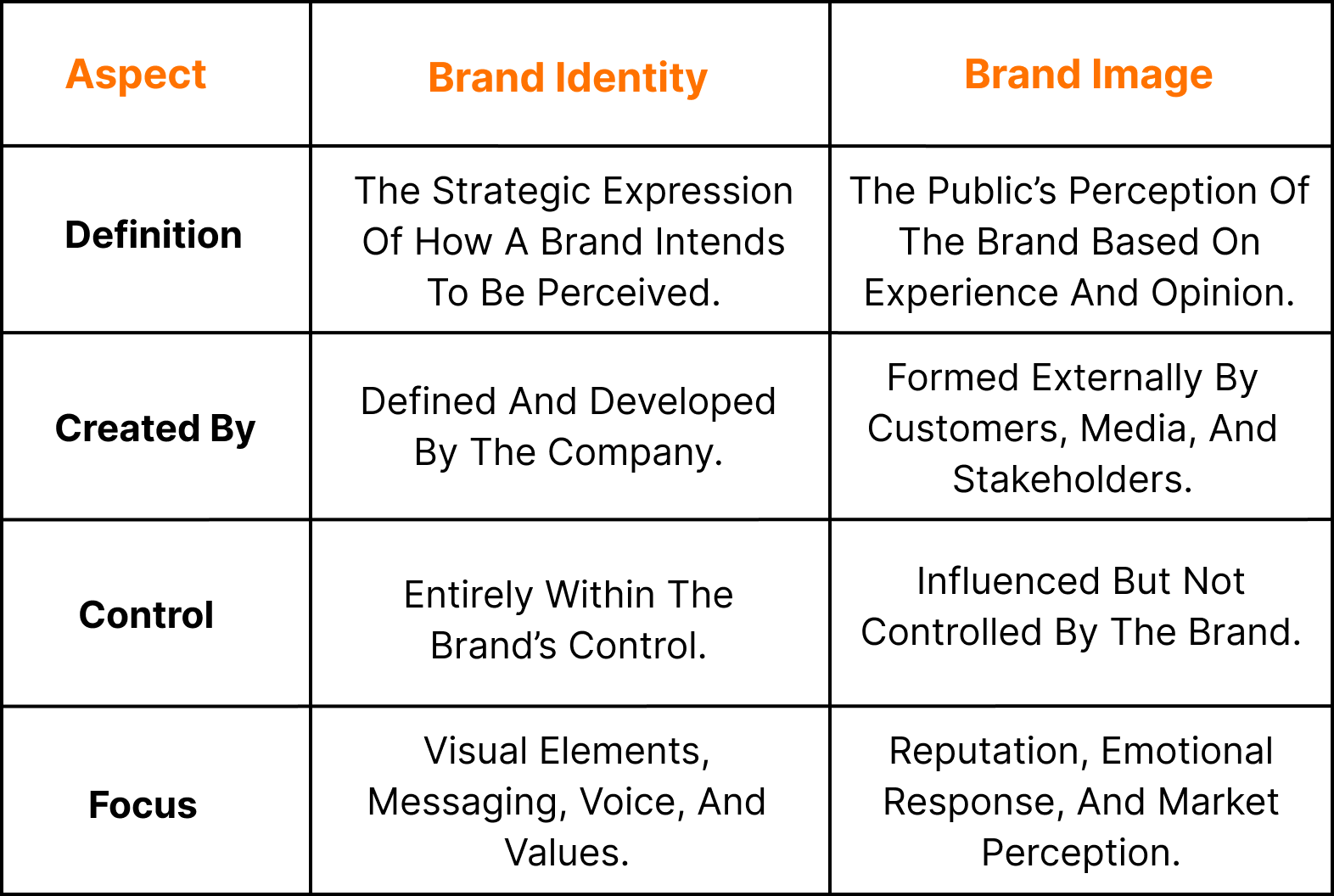
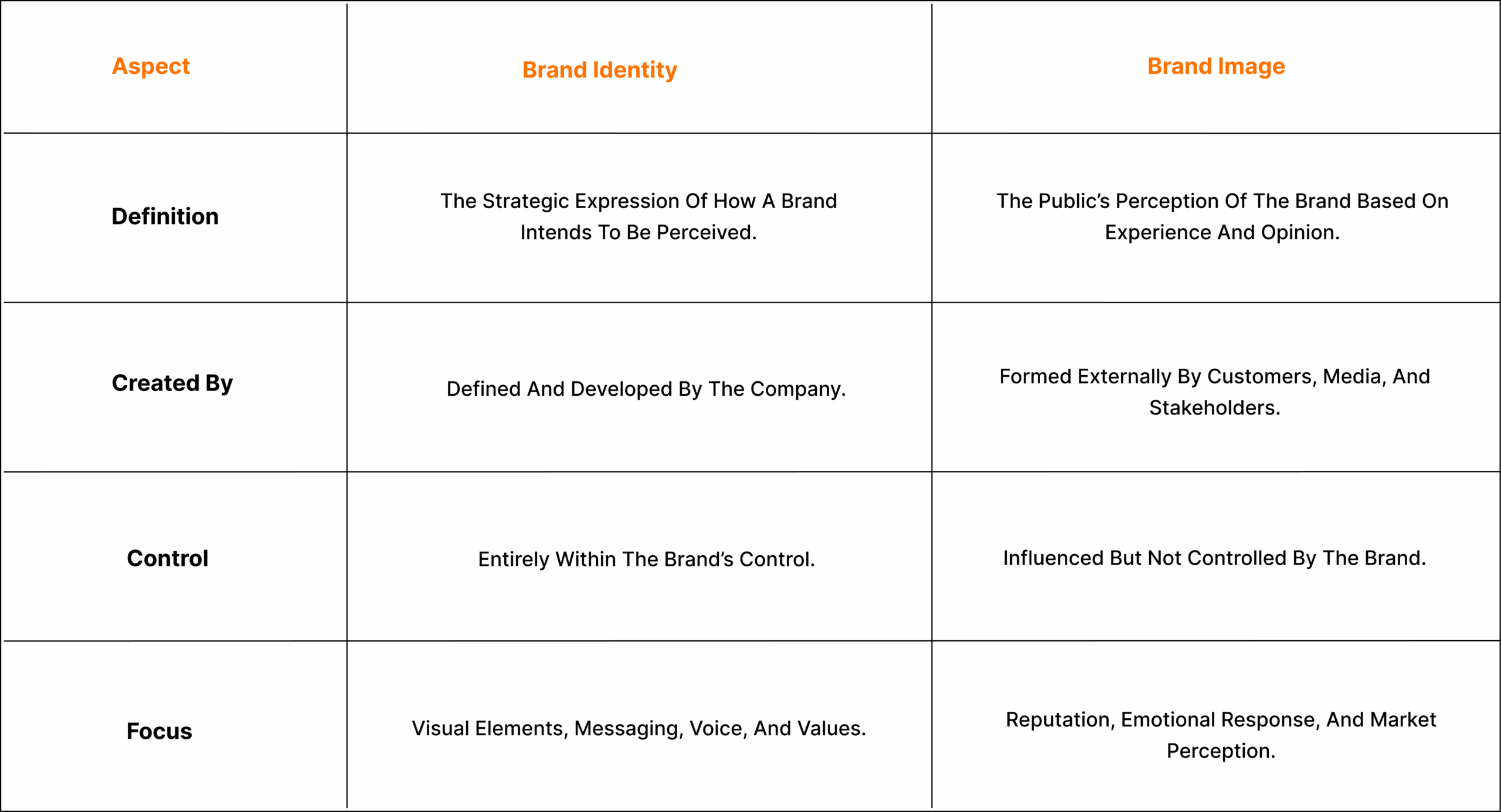
www.craftinggenius.in
The 8 Core Components of Modern Brand Identity
While branding traditionally focuses on visual elements, today’s identity revolves around holistically integrating strategy, user experience, values, and even culture. Let’s go through the eight key components shaping brand identity in 2025:
The 8 Core Components Wheel

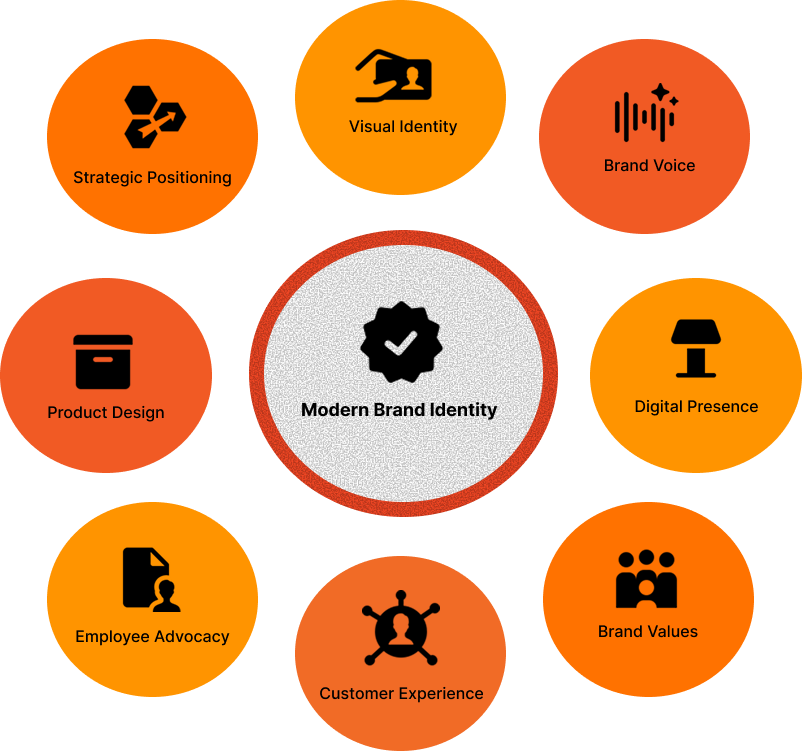
www.craftinggenius.in

www.craftinggenius.in
1. Visual Identity System
A strong visual brand identity produces immediate recognition and consistency. This includes logo design and its variations, a defined color palette which would be based on psychological impact, a clear typography hierarchy, and also the imagery guidelines. RICOH says that consistent use of color can increase brand recognition by approximately 80%.
2. Brand Voice and Messaging.
Voice and how we present messages, which in turn form the brand’s identity across touchpoints. This includes tone of voice regulations, strategic messaging pillars, customer-centered value propositions, and a storytelling approach that puts the brand’s personality and purpose forward
3. Digital Brand Presence
Digital brand consistency is the essence of today’s brand experiences. We see it in responsive-designed websites with optimized UX, in visual themes that run across social media content, in our email templates, and in the mobile app interfaces that align with brand design and function.
4. Brand Values and Purpose.
Purpose-driven branding is the base. We see clear mission and vision statements, which in turn bring internal and external alignment. Also, we have social responsibility programs, sustainable practices, and ethical positioning that build trust and emotional connection with socially aware audiences.
5. Customer Experience Standards.
Experience is a primary factor of brand differentiability, which includes key areas such as service quality metrics, designed interaction frameworks, feedback collection tools, and standardized procedures to resolve customer issues, all of which in turn produce consistent and better customer results.
6. Employee Advocacy Programs.
Employees serve as brand ambassadors. Having a strong internal culture, brand-aligned training, employee advocacy programs, and focusing on consistent service delivery, which in turn enables our staff to present the brand authentically in each customer interaction.
7. Product Service Design.
Your products or services directly define your brand. This includes packaging design, functionality, user interface consistency, and to which we meet quality standards. Each product interaction should boost your brand promises.
8. Strategic Positioning.
Brand position is what sets you apart. It involves identifying your unique features that differentiate from competitors, targeting the correct audience, aligning with where you place in the market, and having a price point that reflects perceived value and brand promise.
Digital Brand Identity in the Metaverse Era
With the rapid evolution of digital platforms, the core formation and representation of brand identity are redefining rapidly. With India’s digital population increasing to over 806 million, brands now cannot afford to operate on web or mobile channels alone. They must now be able to operate within immersive, interactive, and AI-powered spaces.
From Core to Conversion : Mapping the Brand Experience
Brand Touchpoints That Shape Perception And Loyalty

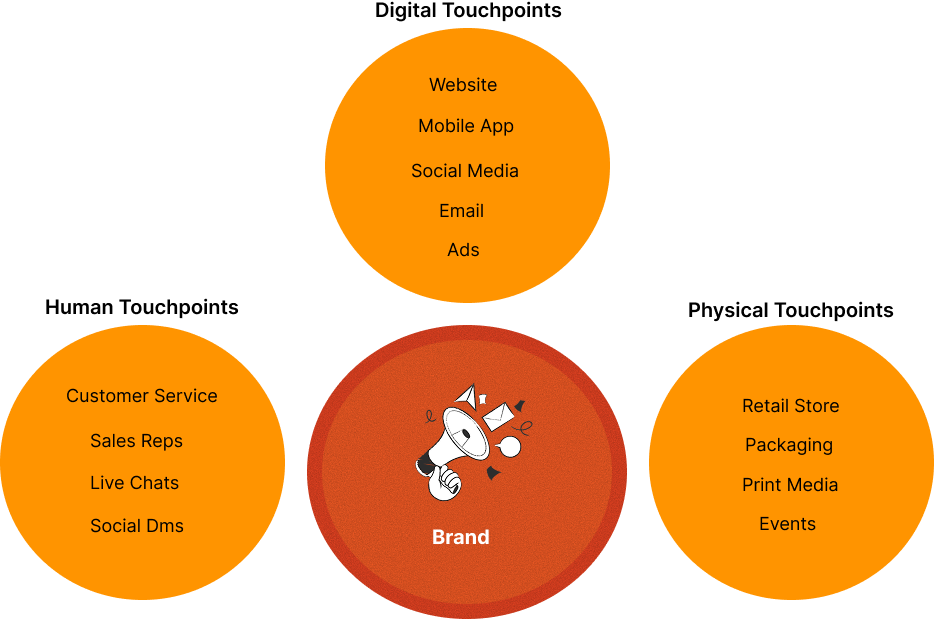

www.craftinggenius.in
71% of Indians say trust in brand interactions is a key factor. [Source: Accenture Life Trends 2025 via MediaBrief] mediabrief.com+1campaignindia.in+1
“81% of retail shoppers conduct online research before making a purchase.” [Source: Invoca – 37 Statistics Retail Marketers Need to Know in 2025] financialexpress.com+11invoca.com+11wix.com+11
“56% of Indian consumers frequently purchase non‑grocery items from physical stores.” [Source: PwC India, Voice of the Consumer Survey 2024 (via Moneycontrol & ET)] pwc.com+4pwc.in+4
The following are the emerging pillars that shape digital brand identity in this modern landscape:
R/VR Brand Experiences
Businesses must come up with metaverse-branding ideas that are truly immersive, which means that, in the extended reality (XR), a branded experience cannot be limited to static visuals. From the presentation of products in 3D to virtual stores and branded game environments, the entire world must echo the brand message, values, and aesthetics. The spatial design, avatar styling, and interaction flows will soon be a new language of brand storytelling.
Voice Interface Branding
With voice assistants and smart devices moving mainstream, brands have to decide how they should sound apart from how they look. This includes the sonic logo or audio branding, voice tone consistency, and conversational personality traits. A well-articulated voice interface identity garners recognition in Alexa, Google Assistant, IVRs, and in-app voice features.
AI-Generated Content
Automated systems today create captions for social media, email copy, variations of designs, and even customer service dialogue scripts. But automation is not to dilute the brand voice. Whatever is generated by an AI should be subjected to brand-guided prompts, human scrutiny, and style adjustments to achieve consistency and trust. Brands should be well defined with parameters to ensure AI augmentation and avoid alienation.
Cross-Platform Consistency
Customers engage with an average of 28.87 touchpoints before making a purchase, while it varies by industry to industry. The brand must stay visually and tonally consistent in this ecosystem. This requires a centralized brand asset management system, design systems of variable interfaces, and clear governance protocols.
AI-Generated Brand Elements: The Authenticity Challenge
As AI takes center stage in brand operations, maintaining brand authenticity while scaling creativity becomes the biggest challenge. To keep this radical innovation with integrity, brands must implement:
1. Human-AI Cooperation
AI should serve more as a creative tool that assists humans rather than replacing them completely. Teams should depend on AI during the ideation process, for speed, and for experimentation, while humans should always conduct the final assessment to ensure context, nuance, and emotional tone.
2. Brand Authenticity Filters
Build checklists or scoring mechanisms to rate AI outputs for tone, visual accuracy, cultural consideration, and strategic fit. Only those outputs that clear these brand integrity filters will be published or used.
3. Consistent Brand Training
If teams are trained in brand values, then so should AI platforms (be it chatbots, brand management, or content creation tools). They should be trained using style guides, tone rules, vocabulary preferences, and approved examples to “learn” your brand voice.
4. Regular Authenticity Audits
Conduct authenticity audits monthly or during a campaign on AI-generated assets to identify tone drifts, inconsistencies, or misalignments. These audits allow for corrections to be made and improve prompt design or tool choices.
Brand Image Evolution: From Controlled Messaging to Social Perception
Understanding of Brand Image in the Digital World
Brand identity emanates from within the company, whereas the brand image is conditioned by external perception – the way the public views, interprets, and interacts with the brand. In the digital era, brand image has turned from a company-controlled narrative to a dynamic, consumer-driven ecosystem. Nowadays, the brand image is thoroughly determined by:
- Customer reviews and ratings online
- Social conversations and virality
- Influencer collaborations and endorsements
- User Generated Content (UGC)
- Public reaction toward brand crises
- Comparisons and positioning against competitors
This transformation has made the brand image flexible, real-time, and highly crowd-sourced
How Social Media Changed Brand Image Formation
With social media, brand storytelling has become revolutionized. It is now consumers who define the perception of a brand, alongside marketers. 80% of internet users in India find out about new brands through social media channels, with nearly 8 out of 10 users depending on online touchpoints for their purchases.
1. Real-Time Perception Changes
- Feedback-loop mechanisms act right away, most of the time in comment sections or tweets.
- Viral content can establish the public opinion—either for or against—within hours.
- The crises begin to spread in a matter of hours, with social media acting as an amplifier.
- Trending topics can temporarily alter brand associations.
2. Influence of User-Generated Content
- Reviews on Google, Amazon, and Zomato play an important role in consumer decision-making.
- Unboxing videos, reels, and customer shoutouts build authenticity.
- Influencer content mixes personal stories with branded messaging.
- Reviews on Google, Amazon, and Zomato play an important role in consumer decision-making.
3. Algorithmic Brand Exposure
- Algorithm changes in Instagram or YouTube level the playing field on brand visibility.
- SEO and the relevance of keywords affect how brands are perceived online.
- Recommendation engines, such as Spotify, Amazon, Flipkart, etc., provide personalized exposure.
- AI-enabled feeds shape perception through relevance and frequency
The Power of Influencer Marketing and Its Role in the Brand Image
The role of influencers today, thus, lies in being the trust proxies for brands. The Indian influencer marketing industry is expected to grow by 25% by the year 2025, according to BusinessStandard Report.
How influencers affect brand image
Authentic Advocacy: Trusted creators give it a human voice and emotional appeal.
Niche Community Access: Micro and nano influencers provide focused demographics.
Co-Creation of Messaging: Brands work alongside influencers in the ideation and creation process of content that appears organic and unscripted.
Image Risk: The ill conduct of an influencer can rapidly impact the goodwill of the brand.
Tools for Real-Time Brand Sentiment Monitoring
Defending their brand image through real-time analytics and a monitor of social media activity remains crucial in this digital era.
Popular Tools are:
- Brandwatch
- Sprout Social
- Hootsuite Insights
- Mention
- Brand24
Key Metrics to Track :
- Sentiment score changes (positive, neutral, negative mentions)
- Share of voices vs. competitors
- Engagement trends across campaigns
- Automated crisis alerts for spikes in negative mentions
- Comparative analytics across markets or audience groups
How to Align Brand Identity with Brand Image: The Strategic Framework
Step by step, let us understand the gap between your intended brand identity with the Brand Perception Gap Analysis Methodology:
Step 1: Identity Documentation
Audit Existing Brand Guidelines
Review your brand book, tone of voice, logo rules, and color palettes. Also, make sure to check if the review items are updated and consistently followed across all departments and platforms.
Map Current Brand Touchpoints
Make a list of all the locations where your targeted audience interacts with your brand. The sites may vary, like ads, packaging, or customer support, then recheck if all individual touchpoints are aligning with your brand and audience.
Document Intended Brand Messaging
Specify how your brand must speak and be perceived. Define tone, language, key phrases, taglines, and emotions they want to evoke across all content.
Identify Core Brand Values
Define the principles that guide the brand in actions and decisions. These values set a direction for its existence, culture, and communication. These should be clear, honest, and evident in everyday business.
Assess Visual Consistency
Check to see if the logos, colors, fonts, and designs are used in a similar way throughout all of the brand’s assets. Although inconsistencies will hinder recognition, going with unifying visuals will develop not only recognition but also trust.
Step 2: Image Perception Research
Conduct Customer Surveys
Get direct feedback from customers on their perception of your brand. Ask about trust, experiences, emotions, and values they associate with you. Use these insights to evaluate gaps and strengths.
Analyze Social Media Sentiment
Analyze feedback on portals such as Google, Amazon, Trustpilot, or app stores. Identify what the public praises or complains about repeatedly to pinpoint the building blocks of your brand image.
Review Online Ratings And Reviews
Analyze feedback on portals such as Google, Amazon, Trustpilot, or app stores. Identify what the public praises or complains about repeatedly to pinpoint the building blocks of your brand image.
Monitor Competitor Comparisons
Keep track of all occasions when your brand is compared with the competitors and note under what criteria or parameters audiences select to go with or refrain from going with your brand. This will help you discover strengths and weaknesses, along with where your brand stands in the market.
Track Brand Mention Context
Check where and exactly how your brand is being mentioned across blogs, forums, media outlets, and influencer content. The context will show your current positioning and what themes folks are associating with you.
Step 3: Gap Identification
Compare Intended VS Perceived Messaging
Look for mismatches in tone, promises, and values. In doing so, you easily find areas where your brand image has not really been received as you intended.
Identify Consistency Weaknesses
These include any areas where branding may be different depending on the platform or the teams involved: visuals, voice, and service tone. Inconsistencies confuse audiences and dilute trust, signifying an internal disagreement on brand execution.
Highlight Reputation Risks
The issues that can gradually tarnish a brand reputation over time—negative feedback, broken promises, bad services. Unless dealt with, it will drain annual brand loyalty—especially if such threats appear across several key touchpoints.
Map Touchpoint Failures
The map could include incidents such as slow support, confusing messages, and unmarked packaging. Failed interactions bring your brand image down while showing you where to immediately start fixing your operations.
Prioritize Improvement Areas
Ranking of gaps according to their impact and urgency. Priority focuses first on highly risky or highly visible issues. This concentrated path to closure will help you efficiently and strategically close the brand identity–image gap.
Step 4: Alignment Strategy Development
Develop Closure Action Plans
For every gap identified, list the specific actions to be taken—redesigns of visuals, trainings, updates to messaging. Assign responsibilities definitively. Each closure plan should articulate specifically how perception can be brought into alignment with the intended identity.
Establish Timeline Milestones
Have your action plans phased against realistic deadlines, with appropriate checkpoints for major updates, testing, and launches. This sort of timeline aligns your strategy to deliver on its promises.
Allocate Resources Effectively
Allocate the budget, tools, and skill set needed to each initiative; prioritize those gaps with the biggest impact. Teams should have their due in resources—whether it be design, content, or support—to accomplish any branding fixes ASAP.
Design Measurement Systems
Set KPIs that will indicate success: brand recall, sentiment score, NPS, engagement rate. Measurement of these KPIs from before and after will provide insights if perception is improving and if identity is getting more clear externally.
Monitor Implementation
Set a feedback, review, and social mention-scanning schedule. Tool up to alert to real-time changes in a brand image and to halt new gaps from arising.
Step 5: Continuous Optimization
Regular Perception Monitoring
Continuously track how audiences perceive your brand using surveys, sentiment tools, and analytics. Frequent monitoring helps catch shifts early and keeps your brand aligned with evolving expectations.
Quarterly Alignment Reviews
Every quarter, review branding efforts across teams. Check if identity still matches image, and if new gaps have emerged. This keeps your strategy current and proactive.
Strategy Adjustment Protocols
Build a flexible framework to update branding tactics based on feedback or market changes. Quick pivoting ensures your brand remains relevant, authentic, and competitively positioned.
Performance Tracking Systems
Use dashboards to track brand KPIs like engagement, loyalty, reputation, and consistency. Visual data helps identify trends and allows leadership to make informed branding decisions.
Stakeholder Feedback Integration
Involve employees, partners, and customers in shaping your brand. Collect input regularly to ensure internal teams align with external perception and that the brand evolves collaboratively.
5-Step Process to Close Identity-Image Gaps
Complete Brand Identity Audit
Review all branding assets—visuals, messaging, tone, and positioning. Ensure consistency, relevance, and clarity in what your brand claims to be and how it expresses itself internally.
Baseline Perception Research
Gather data from surveys, reviews, and social listening tools to understand how your audience currently sees your brand. Establish a benchmark for comparison after changes are made.
Stakeholder Alignment Sessions
Bring together leadership, marketing, sales, and customer support to align on brand vision, goals, and values. A unified internal understanding is essential for building a consistent external presence.
Competitive Analysis
Evaluate how competitors are positioning their brand. Identify gaps, opportunities, and differentiators that can help refine your brand identity and stand out in your market.
Resource Allocation Planning
Plan your budget, tools, and team involvement. Assign responsibilities clearly and ensure every task has the right people and resources behind it for smooth execution ahead
Phase 2: Strategy Development (Weeks 3-4)
Gap Analysis Completion
Finalize comparison of intended identity versus perceived image. Highlight misalignments across touchpoints, messaging, or design to build a focused strategy aimed at closing the most critical gaps.
Alignment Strategy Creation
Develop actionable strategies to realign brand identity and public perception, ranging from communication shifts to experience improvements. Tailor solutions to each gap using brand values as your guiding compass.
Tactical Implementation Planning
Break strategies into executable steps—who does what, when, and how. Create timelines, assign team leads, and prepare rollout logistics for design, content, and customer experience changes.
Success Metrics Definition
Establish key performance indicators like brand sentiment, NPS, recognition, and message recall. These benchmarks will guide ongoing efforts and help measure the effectiveness of identity–image alignment efforts.
Risk Mitigation Strategies
Identify potential obstacles—internal resistance, customer backlash, brand confusion—and build contingency plans. Clear communication and phased rollout help minimize risks and preserve brand trust during transformation.
Phase 3: Implementation Launch (Weeks 5-8)
Develop Closure Action Plans
For every gap identified, list the specific actions to be taken—redesigns of visuals, trainings, updates to messaging. Assign responsibilities definitively. Each closure plan should articulate specifically how perception can be brought into alignment with the intended identity.
Establish Timeline Milestones
Have your action plans phased against realistic deadlines, with appropriate checkpoints for major updates, testing, and launches. This sort of timeline aligns your strategy to deliver on its promises.
Allocate Resources Effectively
Allocate the budget, tools, and skill set needed to each initiative; prioritize those gaps with the biggest impact. Teams should have their due in resources—whether it be design, content, or support—to accomplish any branding fixes ASAP.
Design Measurement Systems
Set KPIs that will indicate success:
Brand recall, sentiment score, NPS, engagement rate. Measurement of these KPIs from before and after will provide insights if perception is improving and if identity is getting more clear externally.
Monitor Implementation
Set a feedback, review, and social mention-scanning schedule. Tool up to alert to real-time changes in a brand image and to halt new gaps from arising.
Phase 4: Optimization Period (Weeks 9-16)
Analysis of Performance Data
Look into brand KPIs such as engagement, sentiment, loyalty, and trends in perception. What’s getting better? What’s stagnant? And which branding activities are producing a measurable effect at the important points customers interact with?
Strategy Refinement
Fine-tune messaging, visuals, or elements of customer experience based on performance insight, replacing something underperforming with a data-approved improvement better aligned with perceived identity.
Continuous Improvement Implementation
Institute a perpetual cycle of brand enhancement, introducing minor tweaks regularly supported by market feedback, to keep the brand relevant, authentic, and malleable to shifts in audience expectations.
Involve Stakeholder Feedback
Stimulate the continuous collection of feedback from employees, partners, and core customers. Utilize their inputs to confirm or reject brand direction and ascertain organizational-wide buy-in.
Course Correction Protocols
Devise a formalized framework for swift response to adverse feedback, potential PR scenarios, or slow drifts away from foundational identity, thus ensuring rapid realignment and preventing long-term detriments to brand image.
Phase 5: Sustained Alignment (Ongoing)
Frequent Cycles of Monitoring
Set up a timetable for monitoring message consistency, consumer feedback, and brand sentiment. Constant observation makes sure the brand stays in line with changing consumer demands and market conditions.
Strategy Reviews Every Three Months
To evaluate current performance, make course adjustments, and ensure that brand initiatives remain strategically aligned with corporate objectives, conduct organized quarterly reviews with leadership and brand teams.
Thorough Audits Every Year
Perform a thorough brand audit that covers identity, image, experience, and perception once a year. To remain competitive and culturally relevant, find new gaps, assess overall progress, and update branding.
Ongoing Team Training
Communicate brand updates, tone, and values to all departments. To guarantee consistent delivery across all touchpoints, provide internal branding resources or refresher workshops.
Financial Impact Metrics:
Brand Awareness Increases: 30-50% improvement
Brand Recall Enhancement: 40-60% better recognition
Net Promoter Score growth: 20-30 point increases
Customer Satisfaction Scores: 15-25% improvement
Employee Engagement Correlation: 25-35% increase
Before Brand Alignment vs After Brand Alignment
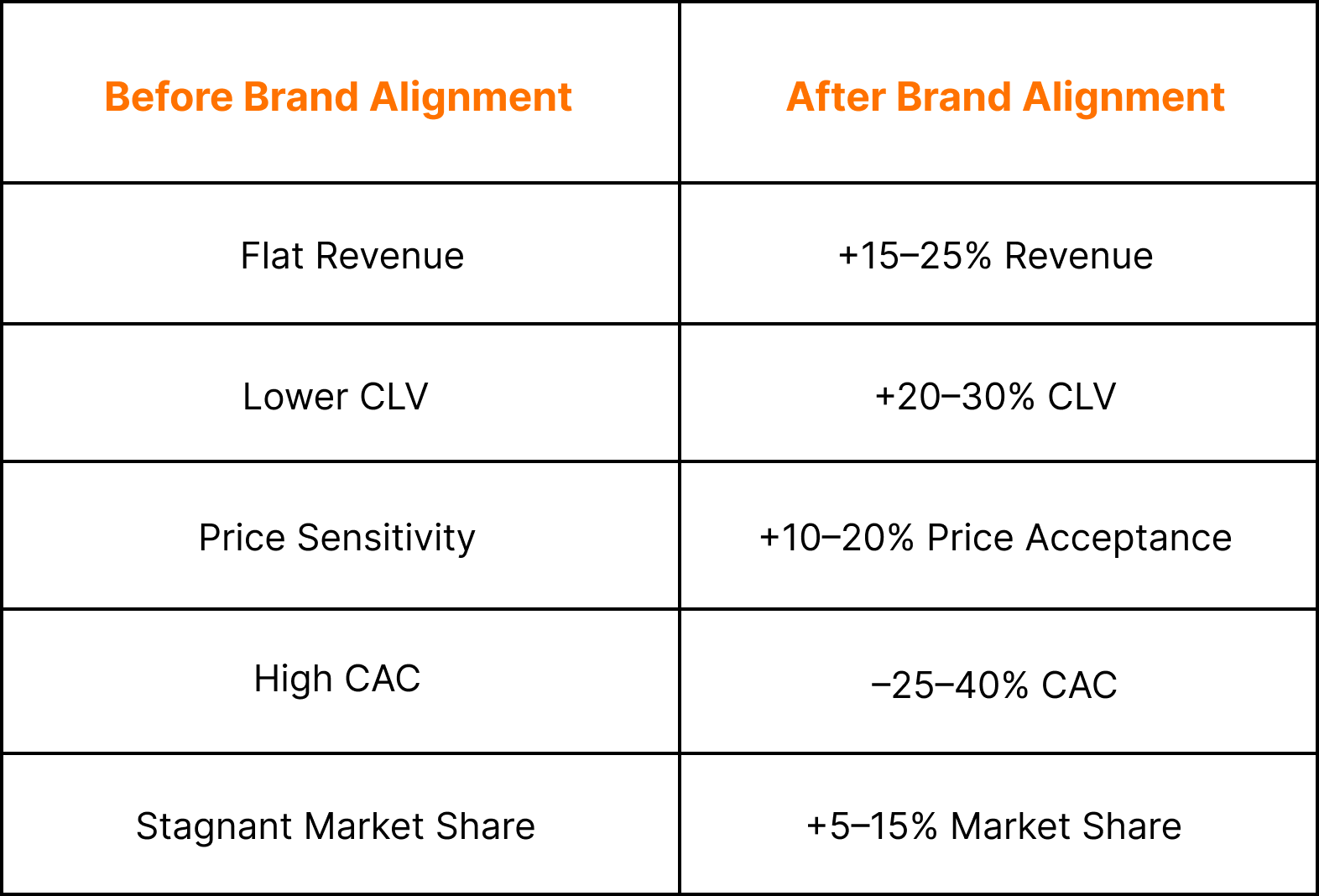
Brand Equity Measurements:
Revenue Growth Attribution: 15-25% increase typical
Customer Lifetime Value Improvement: 20-30% average
Premium Pricing Capability: 10-20% price increase tolerance
Customer Acquisition Cost Reduction: 25-40% decrease
Market Share Expansion: 5-15% growth potential

8 Case Study: Dollar Shave Club’s Identity-Image Transformation
The Challenge
Dollar Shave Club faced a classic identity-image misalignment. Their brand identity positioned them as a premium, convenient grooming solution, but their brand image was perceived as a cheap, low-quality alternative.
Identity Reinforcement:
1. Consistent Premium Messaging
Ensure all communication—ads, captions, customer support—uses refined, confident language that reflects your brand’s premium identity. Consistency builds recognition and reinforces the perception of value and trust.
2. Quality Product Improvements
Enhance product features, materials, or service delivery to reflect brand promises. High-performing offerings naturally reinforce the brand’s identity and earn lasting credibility with customer
3. Professional Packaging Design
Invest in packaging that reflects your brand’s values—clean, high-quality, and memorable. First impressions count, and elevated packaging strengthens the identity at the physical touchpoint level.
4. Strategic Partnership Announcements
Collaborate with credible brands or influencers aligned with your values. Publicizing thoughtful partnerships enhances your brand’s positioning and adds validation from external, trusted sources.
5. Thought leadership content
Publish articles, videos, or insights that demonstrate expertise and innovation in your industry. Establishing authority deepens trust and reinforces your identity as a leader, not just a product.
Image Rehabilitation:
1. Viral Marketing Campaigns
Launch bold, attention-grabbing campaigns that emotionally resonate or entertain. Going viral can shift public focus, refresh your brand’s image, and replace negative perceptions with positive engagement.
2. Influencer Partnerships
Collaborate with credible influencers who align with your desired image. Their endorsements can rebuild trust, validate your brand, and reintroduce it to new audiences with stronger emotional connection.
3. Customer Testimonial Programs
Collect and promote real stories from happy customers. Authentic testimonials help counteract negative narratives and reinforce credibility through relatable, human experiences.
4. Social Proof Amplification
Highlight ratings, reviews, case studies, and user-generated content. Showcasing peer validation builds confidence and restores a trustworthy image, especially if past missteps affected public opinion.
5. Crisis Communication Excellence
Develop fast, transparent, and empathetic communication protocols for handling backlash or mistakes. How you respond during a crisis can either redeem or ruin your brand reputation.
The Results
Brand valuation: $1 billion acquisition by Unilever
Customer base: 3.2 million subscribers at peak
Market disruption: Forced industry leader Gillette to lower prices
Brand equity: Achieved premium positioning in the commodity market
Key Learnings for Modern Brands
1. Consistency Beats Perfection: Regular, aligned messaging outperforms sporadic premium content
2. Authenticity Drives Trust: Genuine brand personality resonates more than polished corporate messaging
3. Community Building: Engaged customer communities become brand ambassadors
4. Agile Response: Quick adaptation to market feedback accelerates alignment
5. Digital Age Challenges: Managing Brand Image Across 15+ Touchpoints
The Modern Brand Touchpoint Ecosystem
Today’s brands must maintain a consistent brand identity across an unprecedented number of customer touchpoints.
Digital Touchpoints (Primary):
2. Mobile applications
3. Social media profiles (Facebook, Instagram, LinkedIn, Twitter, TikTok)
4. Email marketing campaigns 5. Online advertising
5. Online advertising
6. Search engine results
7. Review platforms (Google, Yelp, Trustpilot)
8. E-commerce marketplaces
9. Video platforms (YouTube, Vimeo)
10. Podcast appearances
Physical Touchpoints:
11. Retail locations
12. Product packaging
13. Print advertising Instagram, LinkedIn, Twitter, TikTok)
14. Event presentations
15. Direct mail campaigns
Human Touchpoints:
16. Customer service interactions
17. Sales conversations
18. Technical support
19. Executive communications
20. Employee social media activity
The Indian Market Challenge
With the average Indian spending over 3.2 hours on social media daily, brands face unique challenges in maintaining brand identity consistency:
Language Diversity: Managing brand messaging across 22 official languages
Cultural Sensitivity: Adapting brand values to regional preferences
Platform Preferences: Facebook leads with 64% market share, followed by Instagram
Mobile-First Approach: Optimizing for mobile-dominant user behavior
Price Sensitivity: Balancing premium positioning with value expectations
Influencer Partnership Brand Image Risks
With influencer marketing spending increasing by 16% in India, brands face new reputation risks
Risk Categories:
Authenticity Question: Sponsored content transparency
Value Misalignment: Influencer actions contradicting brand values
Audience Mismatch: Influencer followers not matching target demographics
Content Quality: Substandard sponsored content reflecting poorly on the brand
Crisis Association: Influencer controversies affecting brand reputation
Mitigation Strategies:
1. Comprehensive influencer vetting processes
2. Clear content guidelines and approval workflows
3. Performance monitoring and quality control
4. Crisis response protocols
5. Long-term partnership development
Global Brands Adapting to Local Market Perceptions
ROI of Brand Alignment Statistics
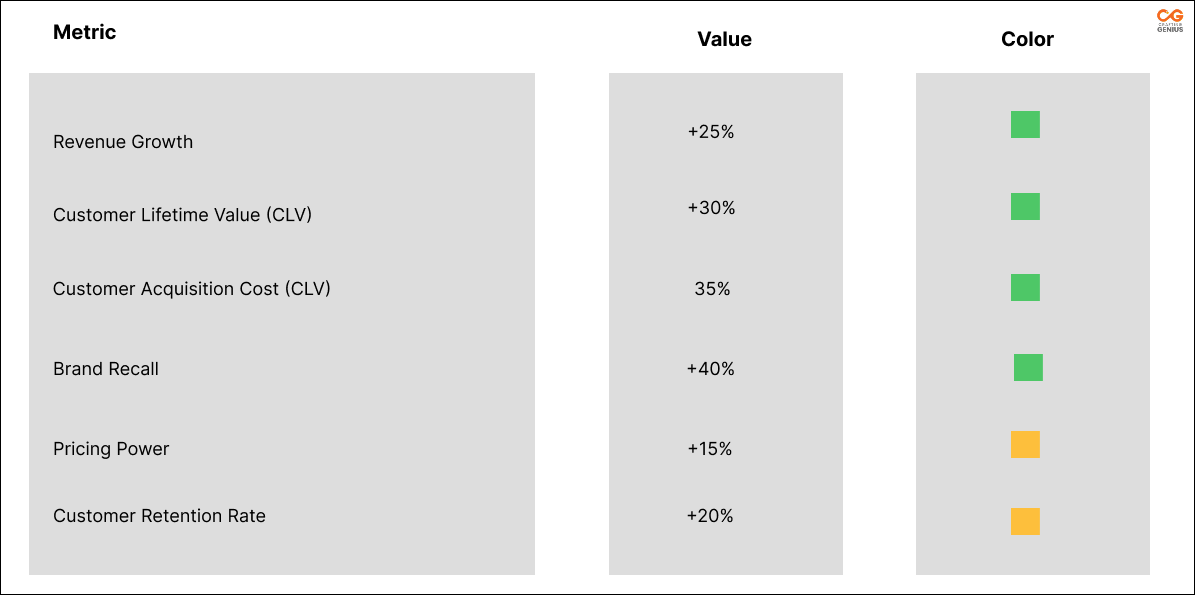
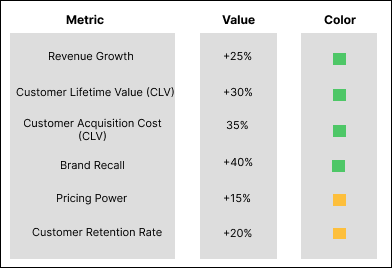
www.craftinggenius.in
Localization Strategies:
Cultural Adaptation: Modifying brand messaging for local values
Visual Localization: Adapting imagery to reflect local demographics
Language Optimization: Professional translation and cultural context
Regional Partnerships: Collaborating with local influencers and organizations
Compliance Alignment: Meeting local regulatory requirements Success
Examples:
McDonald’s India: Vegetarian menu adaptations
Coca-Cola: Regional language advertising campaigns
Netflix: Local content production investments
Amazon: Regional fulfillment and payment options
Actionable Takeaways: Your Brand Alignment Toolkit Monthly Brand Health Monitoring Checklist
Week 1: Social Media Audit
- Review all social media profiles for consistency
- Analyze follower engagement rates (How to analyse it)
- Monitor brand mention sentiment
Check competitor activity - Update content calendar alignment
- Tip: Check if your website, social media, packaging, and emails look and feel consistent.
Week 2: Customer Feedback Analysis
- Compile customer service feedback
- Analyze online review trends
- Survey customer satisfaction
- Review sales team feedback
- Identify service gap areas
Week 3: Digital Presence Review
- Website performance analysis
- Email campaign effectiveness
- SEO ranking monitoring
- Online advertising performance
- Content engagement metrics
Week 4: Strategic Alignment Assessment
- Brand guideline compliance check
- Team training needs assessment
- Marketing campaign effectiveness
- Budget allocation review
- Quarterly planning preparation
Brand Perception Survey Template
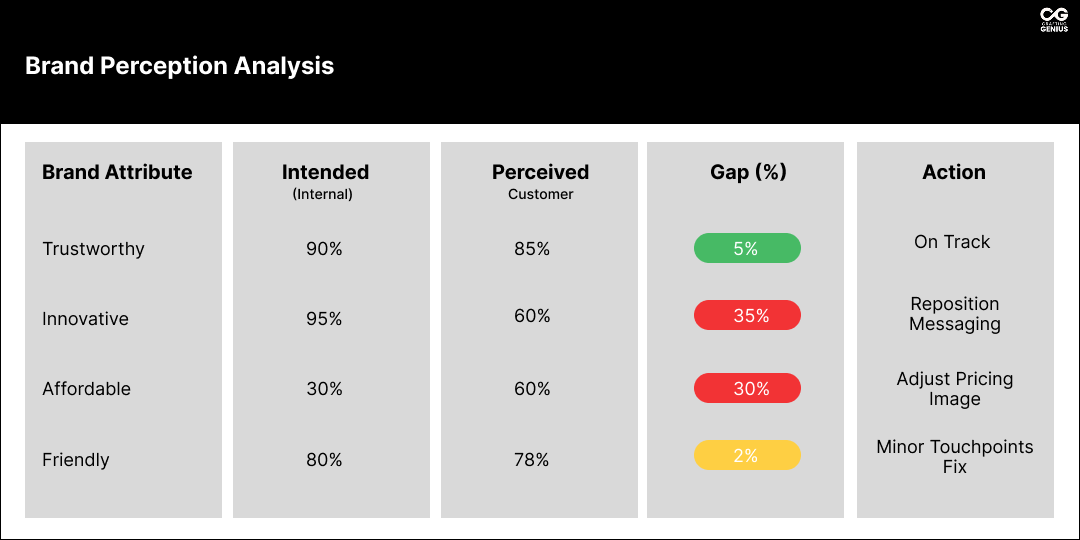

www.craftinggenius.in
Conclusion: In today’s hyper-connected, perception-driven world, it’s no longer enough to define who you are — your audience must feel it, see it, and believe it across every interaction. Bridging the gap between brand identity (your internal blueprint) and brand image (the world’s perception) is the difference between being remembered and being ignored.
With the right framework — from audits to alignment strategies — brands can transform confusion into clarity, friction into loyalty, and recognition into revenue. The brands winning in 2025 are not just visually consistent, but emotionally consistent — inside-out and across all touchpoints.
Takeaway
Brand Image–Identity Questionnaire
